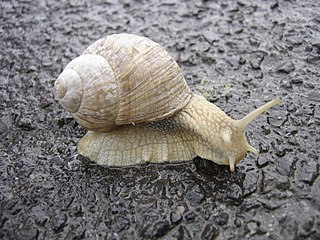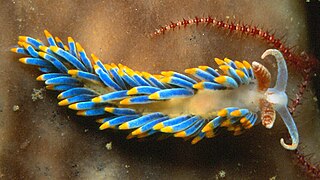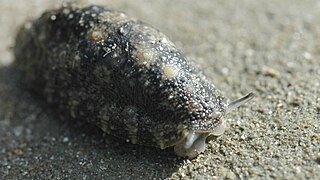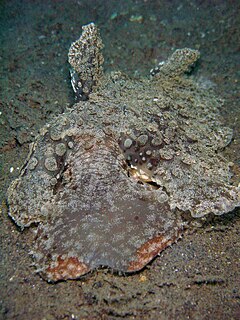Related Research Articles

A snail is, in loose terms, a shelled gastropod. The name is most often applied to land snails, terrestrial pulmonate gastropod molluscs. However, the common name snail is also used for most of the members of the molluscan class Gastropoda that have a coiled shell that is large enough for the animal to retract completely into. When the word "snail" is used in this most general sense, it includes not just land snails but also numerous species of sea snails and freshwater snails. Gastropods that naturally lack a shell, or have only an internal shell, are mostly called slugs, and land snails that have only a very small shell are often called semi-slugs.

The gastropods, commonly known as snails and slugs, belong to a large taxonomic class of invertebrates within the phylum Mollusca called Gastropoda.

Nudibranchs are a group of soft-bodied, marine gastropod molluscs which shed their shells after their larval stage. They are noted for their often extraordinary colours and striking forms, and they have been given colourful nicknames to match, such as "clown," "marigold," "splendid," "dancer," "dragon," or "sea rabbit." Currently, about 3,000 valid species of nudibranchs are known.

The clade Anaspidea, commonly known as sea hares, are medium-sized to very large opisthobranch gastropod molluscs with a soft internal shell made of protein. These are marine gastropod molluscs in the superfamilies Aplysioidea and Akeroidea.

Sea slug is a common name for some marine invertebrates with varying levels of resemblance to terrestrial slugs. Most creatures known as sea slugs are actually gastropods, i.e. they are sea snails that over evolutionary time have either completely lost their shells, or have seemingly lost their shells due to having a greatly reduced or internal shell. The name "sea slug" is most often applied to nudibranchs, as well as to a paraphyletic set of other marine gastropods without obvious shells.

Opisthobranchs is now an informal name for a large and diverse group of specialized complex gastropods which used to be united in the subclass Opisthobranchia. That taxon is no longer considered to represent a monophyletic grouping.

Glaucus atlanticus is a species of small, blue sea slug, a pelagic aeolid nudibranch, a shell-less gastropod mollusk in the family Glaucidae.

Sea snail is a common name for slow moving marine gastropod molluscs usually with visible external shells, such as whelk or abalone. They share the taxonomic class Gastropoda with slugs, which are distinguished from snails primarily by the absence of a visible shell.

Onchidiidae are a family of small, air-breathing sea slugs. They are shell-less marine pulmonate gastropod molluscs. Onchidiidae is the only family within the superfamily Onchidioidea.

Limacia clavigera, sometimes known by the common name orange-clubbed sea slug, is a sea slug, a species of dorid nudibranch. It is a marine gastropod mollusc in the family Polyceridae.

Melibe viridis is a species of sea slug, a nudibranch, a marine gastropod mollusk in the family Tethydidae.

Nembrotha cristata is a species of colourful sea slug, a polycerid nudibranch, a marine gastropod mollusk in the family Polyceridae. This species of sea slug is black with green markings; adults are around 50 mm in length, and they live on rock or coral reefs in the tropical Indo-West Pacific Ocean.

Euthyneura is a taxonomic infraclass of snails and slugs, which includes species from freshwater, marine, aquatic and terrestrial gastropod mollusks in the clade Heterobranchia.
The sensory organs of gastropods include olfactory organs, eyes, statocysts and mechanoreceptors. Gastropods have no sense of hearing.

Chromodoris joshi is a species of sea slug. It is a dorid nudibranch, a shell-less marine gastropod mollusc in the family Chromodorididae.
Nudipleura are a clade of sea snails and sea slugs, marine gastropod mollusks within the large clade Heterobranchia.

Gastropteridae, the bat-winged slugs, is a family of sea slugs, gastropod molluscs in the superfamily Philinoidea of the clade Cephalaspidea, the headshield slugs and bubble snails. The greatest diversity of these colourful small slugs is in the tropical and sub-tropical Indo-Pacific region.

Freshwater snails are gastropod mollusks which live in fresh water. There are many different families. They are found throughout the world in various habitats, ranging from ephemeral pools to the largest lakes, and from small seeps and springs to major rivers. The great majority of freshwater gastropods have a shell, with very few exceptions. Some groups of snails that live in freshwater respire using gills, whereas other groups need to reach the surface to breathe air. In addition, some are amphibious and have both gills and a lung. Most feed on algae, but many are detritivores and some are filter feeders.
Tyrannodoris tigris is a species of sea slug, a polycerid nudibranch, a marine gastropod mollusk in the family Polyceridae.

Terrestrial molluscs or land molluscs (mollusks) are an ecological group that includes all molluscs that live on land in contrast to freshwater and marine molluscs.
References
- ↑ (in German) Westheide W. & Wawra E. (1974). "Organisation, Systematik und Biologie von Microhedyle cryptophthalma nov. spec. (Gastropoda, Opisthobranchia) aus dem Brandungsstrand des Mittelmeeres". Helgoländer Wissenschaftliche Meeresuntersuchungen 26: 27-41.
- 1 2 Jörger K. M., Kristof A., Klussmann-Kolb A. & Schrödl M. (2010). "Redescription of the meiofaunal gastropod Parhedyle cryptophthalma (Acochlidia, Panpulmonata), with focus on nervous and sensory systems". Spixiana 33(2): 161-170. PDF.
| | This Heterobranchia-related article is a stub. You can help Wikipedia by expanding it. |